
Bugatti Type 49
Encyclopedia
The early Bugatti 8-cylinder line began with the 1922 Type 30. The same basic design was used for the 1926 Type 38 as well as the Type 40, Type 43, Type 44, and Type 49.
385 examples were produced, 39 of which were supercharged 38As.
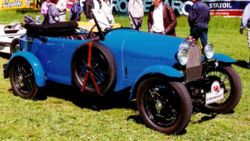
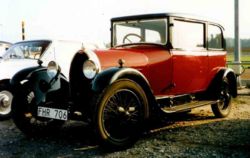
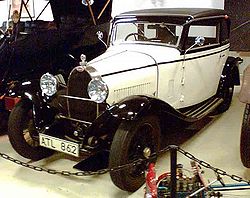
1.5 L (1496 cc/91 in³) engine first used in some Type 37s. It was an enclosed tourer or (as the Type 40A) small roadster
. About 830 were built.
The Type 40A shared its block with the Type 40 and displaced 1.6 L (1627 cc/99 in³). All 40 Type 40As were built in 1930.
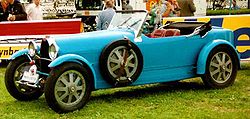
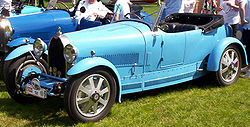
and combined it with the basic chassis of the Type 38. The engine produced about 120 hp (89 kW), bringing the little car to 60 mph (97 km/h) in less than 12 seconds.
The Type 43 was noted at the time as the world's first 100 mph (161 km/h) production car — in fact, it could hit 110 mph (177 km/h) when most fast cars could only reach 70 mph (113 km/h). 160 of these "Grand Sport" cars were made from 1927 through 1931, with a Type 43A roadster
appearing that year and lasting through 1932.
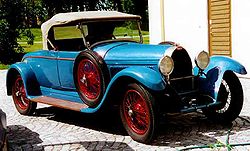
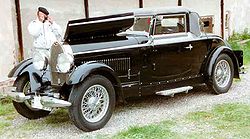
.
The Type 49 featured a straight-8
engine of 3.3 L (3257 cc/198 in³) displacement. Bore and stroke were 72 mm by 100 mm and three valves per cylinder
were used with a single overhead camshaft.
The Type 49 shown in the photo here was owned by the late actor, Charles Bronson
.
Type 30
Produced from 1922 through 1936, the Type 30 used the 2 L (1991 cc/121 in³) engine of the Type 29 racer. It shared its chassis (including the axles and gearbox) with the Type 13 "Brescia". This engine went on to be used in the cut-cost Type 35A and Type 38. About 600 were built from late 1922 through 1926 in varying specifications.Type 38
The Type 38 was produced in 1926 and 1927. It used the 2 L (1991 cc/121 in³) engine from the Type 35A "Tecla". The supercharger from the Type 37A was later fitted, making the Type 38A. Its gearbox and brakes were later used in the Type 40, while its radiator and axles were shared with the Type 43.385 examples were produced, 39 of which were supercharged 38As.



Type 40
The Type 40, introduced in 1926 and produced through 1930, used the 3-valveMulti-valve
In automotive engineering a multi-valve or multivalve engine is one where each cylinder has more than two valves. A multi-valve engine has better breathing and can operate at higher revolutions per minute than a two-valve engine, delivering more power.- Multi-valve rationale :A multi-valve design...
1.5 L (1496 cc/91 in³) engine first used in some Type 37s. It was an enclosed tourer or (as the Type 40A) small roadster
Roadster
A roadster is a two-seat open car with emphasis on sporty handling and without a fixed roof or side weather protection. Strictly speaking a roadster with wind-up windows is a convertible but as true roadsters are no longer made the distinction is now irrelevant...
. About 830 were built.
The Type 40A shared its block with the Type 40 and displaced 1.6 L (1627 cc/99 in³). All 40 Type 40As were built in 1930.


Type 43
Another evolution of the basic 8 platform, the Type 43 borrowed the supercharged 2.3 L (2262 cc/138 in³) engine from the Type 35BBugatti Type 35
The Type 35 was the most successful of the Bugatti racing models. Its version of the Bugatti arch-shaped radiator that had evolved from the more architectural one of the Bugatti Type 13 Brescia, was to become the one that the marque is most known for though even in the ranks of the various Type 35s...
and combined it with the basic chassis of the Type 38. The engine produced about 120 hp (89 kW), bringing the little car to 60 mph (97 km/h) in less than 12 seconds.
The Type 43 was noted at the time as the world's first 100 mph (161 km/h) production car — in fact, it could hit 110 mph (177 km/h) when most fast cars could only reach 70 mph (113 km/h). 160 of these "Grand Sport" cars were made from 1927 through 1931, with a Type 43A roadster
Roadster
A roadster is a two-seat open car with emphasis on sporty handling and without a fixed roof or side weather protection. Strictly speaking a roadster with wind-up windows is a convertible but as true roadsters are no longer made the distinction is now irrelevant...
appearing that year and lasting through 1932.


Type 44
The Type 44 was the widest-production variant of this range, with 1,095 known. A large enclosed tourer, it used a new 3-valve SOHC 3 L (2991 cc/182 in³) engine derived from the Type 43's unit. It was built from late 1927 through 1930.Type 49
The Bugatti Type 49 was an enclosed touring car similar to the earlier Type 44. Produced from 1930 through 1934, about 470 examples were built. The Type 49 was the last of the early 8-cylinder Bugatti line which began with the Type 30, though its gearbox would later be reused on the Type 55Bugatti Type 55
The Bugatti Type 55 was a road-going version of the Type 54 Grand Prix car. A roadster, it had a short 108.3 in wheelbase and light 1800 lb weight....
.
The Type 49 featured a straight-8
Straight-8
The straight-eight engine or inline-eight engine is an eight-cylinder internal combustion engine with all eight cylinders mounted in a straight line along the crankcase...
engine of 3.3 L (3257 cc/198 in³) displacement. Bore and stroke were 72 mm by 100 mm and three valves per cylinder
Multi-valve
In automotive engineering a multi-valve or multivalve engine is one where each cylinder has more than two valves. A multi-valve engine has better breathing and can operate at higher revolutions per minute than a two-valve engine, delivering more power.- Multi-valve rationale :A multi-valve design...
were used with a single overhead camshaft.
The Type 49 shown in the photo here was owned by the late actor, Charles Bronson
Charles Bronson
Charles Bronson , born Charles Dennis Buchinsky was an American actor, best-known for such films as Once Upon a Time in the West, The Magnificent Seven, The Dirty Dozen, The Great Escape, Rider on the Rain, The Mechanic, and the popular Death Wish series...
.

